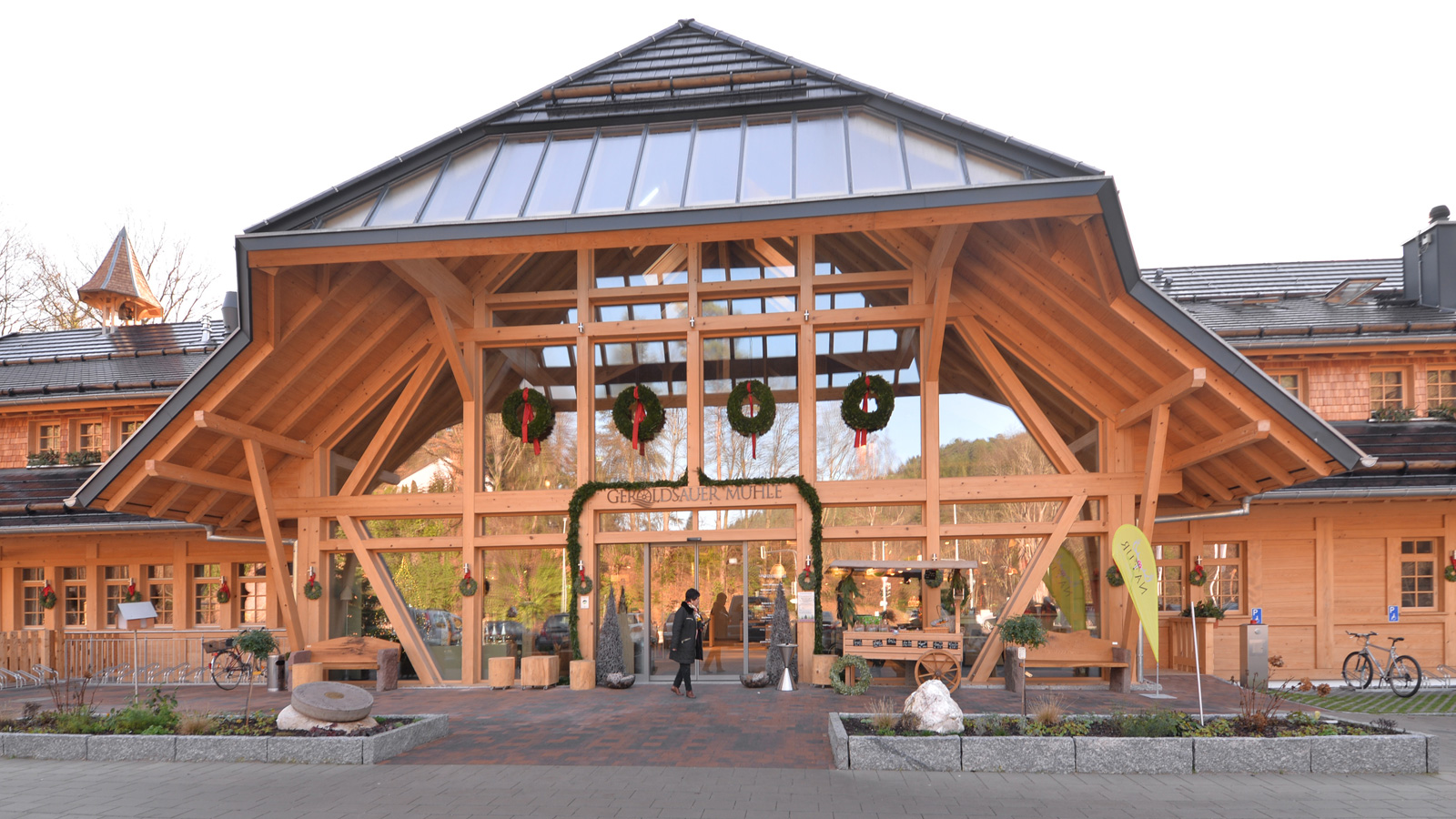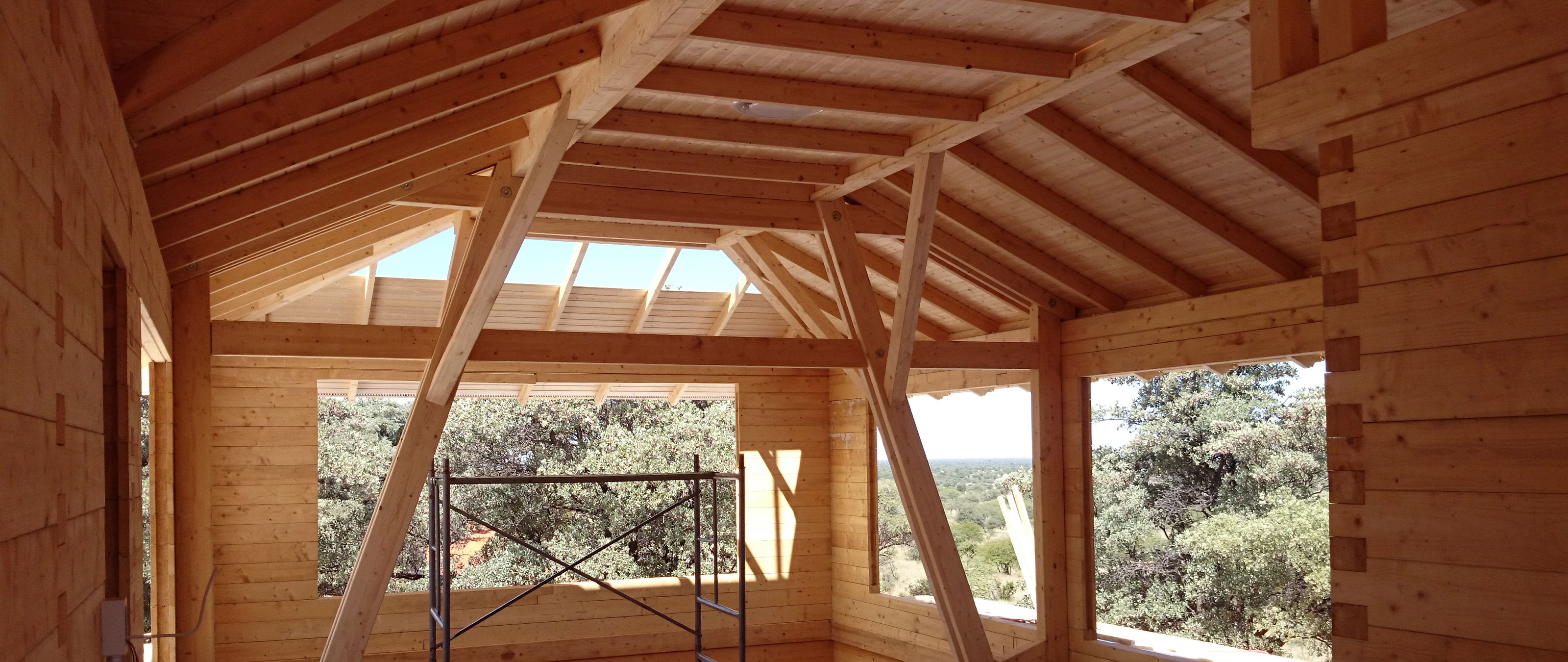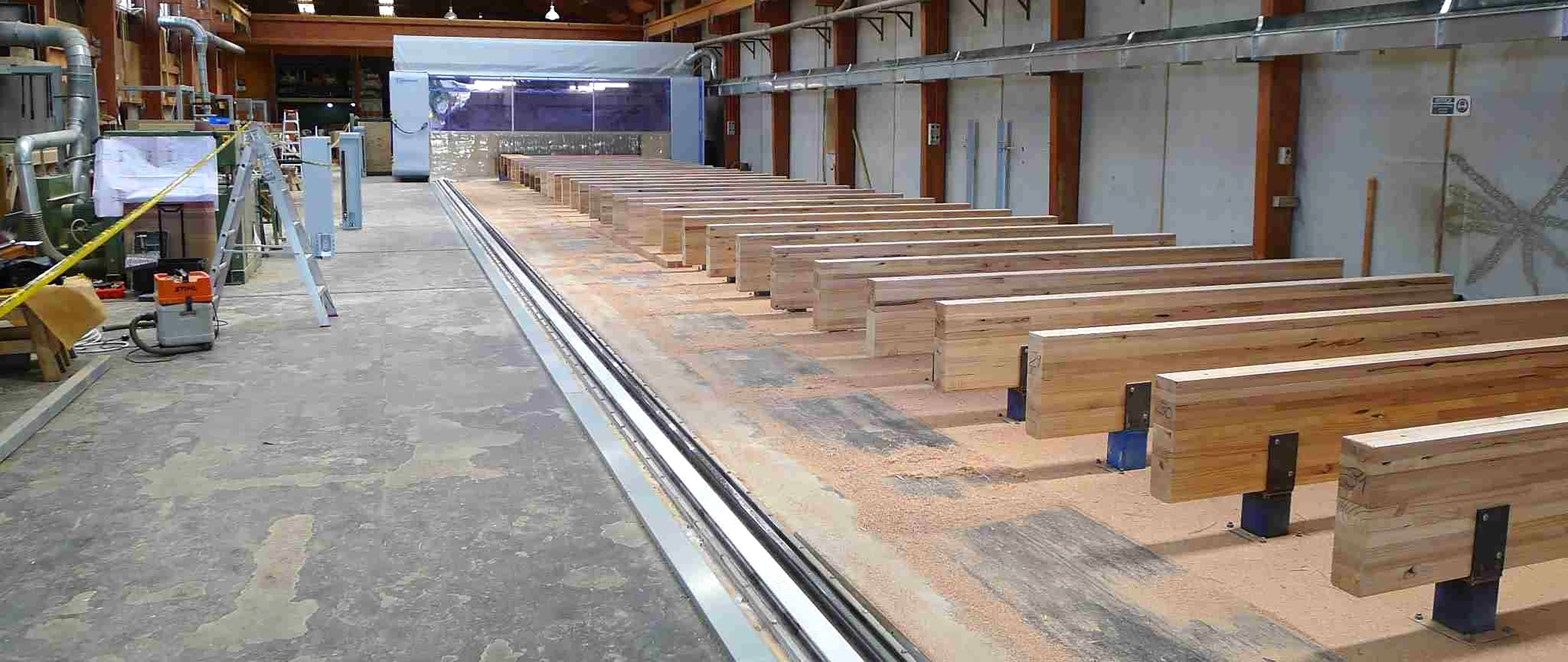
From laminate to laminated wooden beams
Timber work traditionally plays a subordinate role in Namibia. One of the few carpentry shops to be found in the South African country, the company in the city of Swakopmund belongs to a carpenter of German descent. Christian Hess and his company erected a tower for the German school once he had become a journeyman carpenter following his carpentry training in Westerwald.
It was to be the last country he traveled through, before returning to Germany to complete his military service and to attend the college for master craftsmen. But the country between the Kalahari and the South Atlantic would not let him go, even after that. He initially alternated between Germany and Namibia for seven years, before founding the Carpentry Hess timber work company in Windhoek in 2007.
Just laminate to start with
Windhoek suggested itself, because there was practically nothing else comparable in the Namibian capital: "Apart from me, there was just one young carpenter, who never managed to make the breakthrough and made a living from building kitchens", remembers Christian Hess. He also spent several months at the start laying laminate floors, while every now and again there was a small order for a porch or a staircase — work that Hess continues to offer to his customers today.
Between then and now, quite a lot of time has passed. The breakthrough started after a fire in a gymnasium, for which Hess was to produce the roof dormers on the new building: "At that time, I produced the CAD plan for the complete roof structure and gave the German building contractor a quotation. As our pricing was cheaper than the steel manufacturer, we got the job. Once we had assembled the roof structure, things took off. "
On this project, Hess worked with South African laminated timber, the quality of which did not meet his standards. The next project, a large upwards extension, was realized using solid construction timber from Germany. Timber products are so expensive in South Africa that it still continues to be worthwhile to import them.
At that time, Hess imported around two containers of solid construction timber per annum, increasing to 20 containers by 2014 — that is around 1000 m³ of timber. Since 2015, he has been producing on a 30-year-old finger jointing line. "We use this equipment to produce Duolam and Triolam for our roof structures, and sometimes we sell to other companies. We are the only company in Africa producing spruce laminate up to a length of 30 m. "
One of the reasons for starting laminate production was the waste resulting from solid construction timber, while another reason was the rising call for larger spans. Thirdly, demand increased for round and bent constructions. This meant that the projects carried out by Carpentry Hess were highly publicized and timber work became more popular with every project. A constantly growing trend, which recently peaked in a hall roof that is supported by 28-m long laminate beams.
Full order books
The customer in this case was an entrepreneur of German descent. Those of German descent make up around four percent of the just over two million inhabitants of Namibia. One larger section of the population is made up by the Boers, who, together with those of German descent, form the main customers of Carpentry Hess.
This may be one of the reasons why Christian Hess' order books are full to the brim, while the Namibian economy is currently under great pressure: Due to a long-lasting drought, the export income from the meat trade with Europe and America has shrunk.
With his high-quality products, Hess is positioned in the upper market segment and tends to attract the more prosperous sections of the population, who are not so greatly affected by this development. Roof structures and laminated wooden beams have now emerged into the main business areas, although Hess also takes on work relating to block houses, staircases and classic carpentry work.
Christian Hess hardly ever builds timber frame constructions: "Mainly for the reason that we do not have either suitable plasterbase sheeting or the correct insulation here. We once erected a lodge in timber panel construction, which we protected against the weather by attaching a transparent corrugated polycarbonate panel to the outside."
Of course there is no pressure on the carpenter to expand his business in this sector, as the demand for his services in Windhoek is now so great, that "there could easily be one or two more carpenters here."
This is even more the case, since Hess has reduced the number of orders he takes on due to his entry into wood gluing: "Earlier we could run our solid construction timber over the carpentry machine and then mount it. Today we have a longer start-up phase in production, but also better value creation per order. "
Beam processing by dimension
The carpentry machine is, of course, still in operation. Hess bought it three years ago, when his company was making an average of 100–120 m³ of beams manually per month: "But it was not just about the sheer quantity, but also that we have complicated roof styles here in Namibia with lots of different roof lines, including uneven slopes. For this reason, it made sense to look at purchasing automated and extremely precise plant."
A little while ago, Hess spent some time researching this online, and kept coming back to WEINMANN in Lonsingen: "With the WBS 140, they were offering precisely the machine that fitted our profile: it is small, compact, and can do everything. We didn't need to build a new hall, didn't need any additional foundations, and the transport costs were manageable.
The machine is also energyefficient — this is an important factor when you consider the power supply in this country — and it works very precisely, to which we attach particular importance, as we want to offer a high level of quality and we generally produce visible roof structures."
Ultimately it was also reassuring for the Namibian carpenter that the global marketing and service network of the parent company, HOMAG, stood behind WEINMANN: "This means that, even in Africa, you can count on someone coming to see you immediately, if you ever hit a problem."
The machine was ordered, delivered, and — thanks to wellorchestrated preparation — commissioned after just three days: “We pressed the first button and away she went. — We were impressed."
Since then, the WBS 140 in Namibia has made diagonal holes, dovetails, and roof frames, has already made the beams for a twostory block house, is used in the production of staircases, and is continuously tested with new processing variants. According to Christian Hess, it has not just drastically reduced the level of waste, but has also increased the company's turnover by 30 percent.
Service requests work as expected: "If there is ever a problem, I quickly have a service technician on the phone, who can rectify the problem by means of remote diagnostics. Once a year, a technician calls by to make sure that everything is working fine. So far, we haven't had any major problems."
One conclusion arising from the development of Carpentry Hess in Namibia — which today has reached a point with glued timber production, the carpentry machine and full order books — is that Christian Hess really does not want to change anything. Perhaps just one thing: "If any more carpenters were to set up here, I would possibly reduce the amount of assembly work and concentrate more on the selling of glued timber and beam processing."
Solid wood for New Zealand
In New Zealand, timber work is traditionally very strongly rooted in the form of "timber framing". Around 90 percent of detached and semidetached houses are designed with a timber frame construction. This is encouraged by the fact that their light, elastic designs offer better protection against earthquakes in the country's extensive earthquake zones.
As in Germany, there are also products made from crosslaminated timber (CLT). However, these have not played a major role in the building industry for a number of years. One of the reasons for this is that these are imported products, with dimensions restricted by the necessity to transport them by sea.
Quick start from Zero
However, in spite of this background, over the last few years there has been a strong trend towards CLT construction methods in New Zealand, which is partly to the credit of XLam NZ Ltd, located in Nelson. This company was founded by brothers Robin and Ian Jack. When they started the first production of crosslaminated timber in the southern hemisphere in 2012, the solid wood elements were produced exclusively manually at that time.
In other respects they were also starting from zero: "If I look back today, at what we did when starting XLam, I can hardly believe it," remembers Robin Jack, the former managing director of the company, who has recently retired: "We built up the production for a product that nobody knew what do with — that hardly anyone had even heard of! But someone needed to pave the way, and CLT is the biggest opportunity I have ever seen in my 40 years in the timber industry."
After using a market study to check that there really was a market for the new material, the next step was to invest in a WMP 240 from WEINMANN. This solid wood portal was to process the elements that would be manufactured in production.
"Not because we had problems with manual work," explains Neil Dodunski, the General Manager at XLam: "We had qualified employees, who were proud of their craft. But we would not have been able to grow without accelerating our processing of elements."
Equipped with a flexible sawing unit and a 30-kW 5-axis main spindle that can spin at speeds of up to 18,000 revolutions per minute, the WMP 240 processes solid wood elements of up to 350 mm thickness at high speed and with high levels of precision. At the same time, the saw and the spindle can be swiveled through up to 90 degrees in the A axis and rotated through up to 360 degrees in the C axis, which opened up a large range of processing options to XLam.
All the more so, as the main spindle is equipped with an 18-slot disk-changer, which enables different tools and additional units to be replaced automatically during processing. As the machine works through the orders fully automatically, it is operated by just one man.
Fast, precise, safe
The employees who previously processed the CLT elements with manual machines are now responsible for work preparation using Lignocam software in the Nelson plant. Their initial fears that their jobs would lose their attraction due to the introduction of CNC production were unfounded.
Neil Dodunski: "Their timber work specialist knowledge is still required in order to expertly plan the machine's processing steps, and they must watch out for every detail."
Gary Caulfield, the new Managing Director of XLam, sees great advantages in the use of CLT elements on the construction site when compared with traditional construction methods: "This enables construction sites to be very clean and tidy places, because the main part of the work is carried out with the machine in the production hall. This also means: Safer construction sites for the workers. And special focus is placed on safety in Australasia."
However, in New Zealand, it is not just a matter of safety. The biggest strength of the new construction method lies in the short assembly times: Because the elements are very lightweight in comparison with other solid construction materials, it is currently no problem for XLAM to mount fit 100 m²/h on a construction site — as long as the elements have been produced to the required level of precision. This is so high, that in Nelson they are already dreaming of a construction site without a meter rule.
Greater capacity & new work opportunities
To get to this point, the company had to come a long way. Amongst other things, it needed to produce the appropriate evidence for the building inspection authorities for the product — substantially knotfree crosslaminated timber from the fastgrowing, native Radiata Pine. There was also a lot of convincing to be done in architectural practices and at universities to open up the doors for the new building material.
The reward for all of the hard work is an excellent position in the market. Since the product was introduced, demand has increased steadily; currently, larger properties such as schools, kindergartens, halls of residence, department stores and even hotels are increasingly built from CLT. This is only in part due to the fast construction method and the high loadbearing capacity: This sustainable and emissionsfree construction method is a fitting match for the strong ecological awareness in Australasia.
Commercial enterprises can make an ecological statement with buildings like this; day care centers become particularly attractive when using the natural, healthy living construction material. The design options of the new material with its fine surface finish are also convincing — including when used in combination with the 5-axis capabilities of the WMP 240: "We are happy to tell the architects: If you can draw it, we can make it," explains Gary Caulfield: "Although we are making our life difficult by saying that. Of course, then the architect comes back to us with a design that doesn’t have a single right angle in it."
XLam now delivers its elements to New Zealand, Australia and the surrounding islands.
Published in Mikado 12 / 2016
Many thanks to the Editor Jessica Jahn and Dr. Joachim Mohr
Pictures: Holzbau Carpentry Hess and XLam NZ
“The machine is also energyefficient and it works very precisely, to which we attach particular importance, as we want to offer a high level of quality and we generally produce visible roof structures.”Christian Hess, Carpentry Hess
More about Carpentry Hess and XLam NZ
In 2007 Christian Hess founded the Holzbau Carpentry Hess in Windhoek (Namibia). Today 17 employees work there. Carpentry Hess is the only Business in Africa that produces, cuts and installs glued timber up to a length of 30m.
The Brothers Robin and Ian Jack founded the Company XLam NZ in 2002 and is dedicated to the supply of sustainable engineered building solutions in natural solid wood. Employing the latest CNC machining technology, over 150 CLT projects have been completed to date, with many more in the pipeline.











